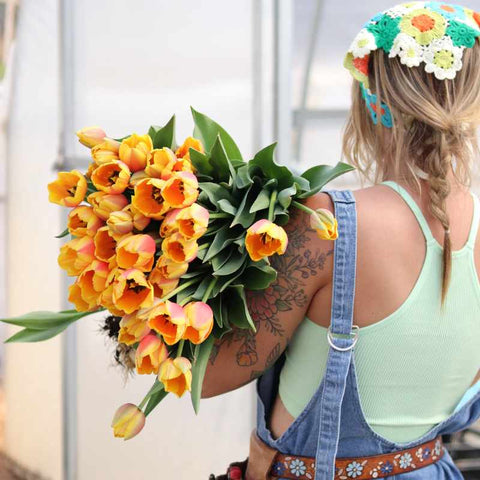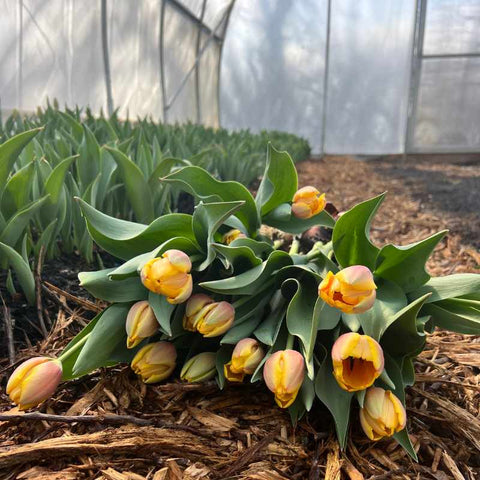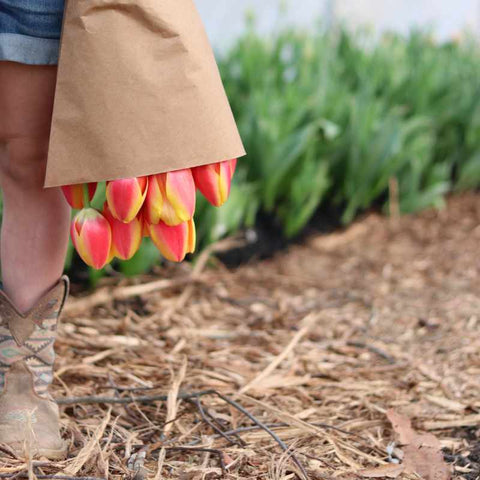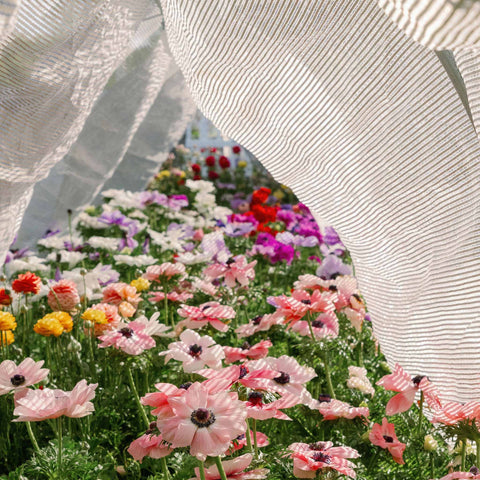20% Off USA-Made All-Metal Greenhouse Kits until May 31
20% Off USA-Made All-Metal Greenhouse Kits until May 31
Season Extension on a Flower Farm
January 29, 2025 6 min read 0 Comments

Infrastructure for Season Extension on a Flower Farm
Season extension infrastructure, such as hoop houses, low tunnels, CAT tunnels, and storage sheds, can significantly enhance the profitability of a cut flower farm. Hoop houses provide a controlled environment, protecting plants from extreme weather and extending the growing season, though they come with moderate to high initial and maintenance costs.
Low tunnels are more affordable and easy to construct, offering frost and pest protection, which allows for earlier planting and extended harvests with low to moderate costs. CAT tunnels offer flexibility, movability, and protection from harsh weather and pests, requiring a moderate investment. Storage sheds, essential for equipment and harvested flowers, ensure efficient operations and reduce losses.

Benefits of a Hoop House on a Flower Farm
In certain areas, hoop houses offer a significant market advantage for flower growers. These simple structures allow for earlier blooms and longer seasons, giving you a competitive edge in the market.
One of the key benefits of hoop houses is the protection they provide against wind, elements, and pests. With unpredictable weather patterns and shortened growing seasons, late or early frosts can wreak havoc on your flower crops. By implementing a hoop house over designated beds, you can safeguard your flowers and ensure consistent production.
Additionally, hoop houses create an optimal environment for your flowers. The structure helps warm the soil to the ideal planting temperature and maintains warmer ambient air temperatures. This means that you can start producing beautiful blooms up to 6 weeks before others, giving you a head start in the market.

Season Extension in a Hoop House
A hoop house is ideal for early spring flowers such as ranunculus, anemones, and tulips. In the fall, a hoop house protects those plants that would otherwise perish upon the first frost.
Hoop houses allow those in farther northern climates to grow a crop that otherwise wouldn't be as successful or reliable. It helps warm the soil for planting and provides much-needed protection in fluctuations and potential late frosts. This video from NDSU has some great statistics showing how the addition of a hoop house can produce cut flowers far earlier than field-grown. Field to Fork 2021: High Tunnel Cut Flower Production
Even though many spring plants thrive in cooler weather, they may not entirely survive an unexpected late frost. If further extreme weather arises, you can cover crops directly with a simple frost cloth inside the hoop house, providing additional protection.
Related: How Do Frost Blankets Help Prevent Crop Loss?

Weather protection for your flower crop
Weather volatility has been increasing over the years, preventing growth, reducing yields, weakening stems, or causing the cut flowers to go to seed sooner than anticipated. A hoop house structure combined with highly durable UV-resistant plastic, proper ventilation, drip irrigation, and shade cloth can create the ideal microclimates by providing shade, controlling moisture, and preventing extreme weather from wiping out your crop.
Cut flowers that thrive in a high tunnel or hoop house
Any cut flower planted in a high tunnel in early spring will usually produce weeks and sometimes months earlier than those planted in the field. Many flower farmers take advantage of this by planting crops like snapdragons, Cerinthe, stock, and feverfew in the high tunnel in late fall and then again in the field come spring.
Some flowers are particularly well suited to hoop house growing because of their delicate nature. Keep in mind that trellis netting is very important as much, if not more so in the hoop house to ensure straight and tall stems. Gravitropic flowers like snapdragons can bend down and become wavy stemmed without this support.

Lisianthus: They find the protective growing environment ideal and are a well-sought-after product in the local cut flower market. Because lisianthus blooms can be stained by rainfall, making them unsaleable, hoop house grown blooms can fetch a premium and produce more market-ready flowers. Many growers note that even during the summer heat, Lisianthus thrives in a shaded hoop house.

Ranunculus: Much like lisianthus, ranunculus can produce as much as a month earlier, given the protected conditions of a hoop house. Adding shade cloth in the late spring will also produce the longer stems sought after for arrangements. There is a great ranunculus production budget breakdown available from Utah State University showing how one 14x40 high tunnel can produce close to $9,000 worth of sales in one year.

Dahlias: Providing a stable environment can produce blooms a month sooner! Having flowers in July vs. August and September can always boost your sales. Also, having frost protection and allowing for a more extended dahlia-producing season is a bonus! Dinner plate Dahlias also enjoy the stable environment provided by a hoop house. Environmental stressors in the field can result in shorter stems.

Iceland Poppies: These beautiful blooms, while spring growing, really benefit from hoop house protection. They are more delicate than others and enjoy a much more stable environment vs. field-growing conditions.
Pest Management for Cut Flower Production
Having a hoop house, big or small, can provide much-needed peace of mind regarding pest and disease management. While you cannot eliminate all problems, you can proactively manage them by quarantining your crops and providing proper protection and stable conditions.
Adding insect netting will help keep pests out while also keeping any beneficial insects you release for biological control within the structure.
Related: Insect Netting for Pest Protection
What is a hoop house?

Hoop houses, also known as high tunnels, are simple but effective structures that provide protection for crops against harsh weather conditions. These structures consist of hoops covered with plastic, creating a sheltered environment that shields plants from wind and rain.
One of the key benefits of hoop houses is their ability to harness solar energy and extend the growing seasons. By capturing solar gains at the beginning and end of the growing seasons, flower farmers can start cultivating earlier in the Spring and continue harvesting later into the Fall. This enables you to maximize your crop yields and extend your growing potential.
When it comes to building a hoop house, farmers have various material options to choose from. Popular choices include different gauges of metal, wood, and PVC (although not recommended). The choice of material depends on individual preferences and goals. Some farmers may prioritize saving upfront costs, while others may opt for a stronger structure that will last for multiple seasons.

Round Hoop Houses vs. Gothic Style High Tunnels
Gothic high tunnels are often preferred for cut flower production in northern regions because the increased air volume helps stabilize temperatures. The peaked roof also helps to shed snow during the winter months. For more information on How Volume and Air Mass Affect Heating and Cooling in a Hoop House take a look at this video.
Round hoop houses are commonly used in areas that do not experience winter snow. They are usually lower cost but equally effective in protecting crops in more moderate climates south of the 40th parallel.
Related: Cut Flowers for High Tunnels: A Beginner’s Plant Guide
Extending the Season without a hoop house

If a hoop house is currently out of your farm's budget, there are still effective ways to protect early spring flowers. Consider using DIY low tunnels, cost-effective Cat Tunnels, or harnessing natural elements such as straw mulch & windbreaks to create microclimates. These alternatives can provide the necessary protection without breaking the bank.

Adding low tunnels for season extension and flower trellis support
One of the most inexpensive and beneficial ways to get started is to create a miniature version of a hoop house called a low tunnel. You can easily make the hoop-like structure by purchasing EMT conduit from your local hardware store and slowly bending it over a securely fastened hoop bender. For even more support you could add EMT cross connectors and purlin horizontal bracing to your low-tunnels for more rigidity.
Check out: DIY Low Tunnel Upgrade | Stronger, Mobile 4 Season Growing
Creating this smaller version of a hoop house will still provide an improved growing environment using greenhouse plastic, shade cloth, or frost cloth. We love its versatility beyond outside protection and use the hoops to stretch trellis netting parallel to the ground for additional plant support.
DIY low tunnel structures are affordable, multifunctional, and reliable on a small scale. Suppose this is your first step toward adding any structure to your operation; invest in a quality hoop bender and immerse yourself in understanding beneficial ways to use a hoop-like structure.

Using a CAT Tunnel for Season Extension on your Flower Farm
Caterpillar tunnels are a versatile tool that can help you extend your growing season or get a head start on planting. By warming the ground and protecting new plants from late spring frosts, these tunnels provide a simple yet effective means of safeguarding your crops.
Opening the ends provides passive ventilation. While they do not provide the same level of environmental control that high tunnels with end walls and added ventilation do, they are a cost-effective option for getting an early start on spring planting. CAT tunnels can also double as shade tunnels in the heat of summer by raising the sides and adding shade cloth.
Related: High Tunnel Vs Caterpillar Tunnel
Building a high tunnel on your flower farm can provide numerous benefits for the growth of your business. You will be able to extend the season and improve crop yields. With careful planning and investments in quality materials over time, you can maximize these benefits and start growing amazing flowers in a protected environment. Investing in a hoop house is an exciting and beneficial enhancement for any flower farm that can help take your business to the next level.
Subscribe
Sign up to get the latest on sales, new releases and more …
